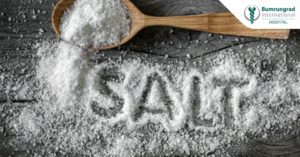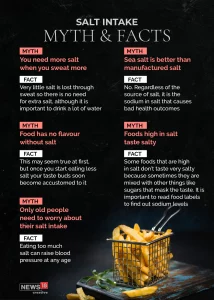Now, let us get in the specifics of the electrolyte sodium chloride and health.
Table salt is made up of the elements sodium and chloride – the technical name for salt is sodium chloride. Your body needs some sodium to work properly. Na in our body plays important roles and works with potassium. It helps with the function of nerves and muscles. It also helps to keep the right balance of fluids in your body. When Na gets high concentrated (in blood=hypernatremia) our body reacts by allowing more water in that compartment (ex. Plasma) to balance out the electrolyte and fluids in that compartment to prevent complications. Your kidneys control how much sodium is in your body. If you have too much and your kidneys can’t get rid of it, sodium builds up in your blood (hypernatremia). This can lead to health problems. In healthy individuals, the kidneys respond to excess sodium by flushing it out in the urine. Unfortunately, this also removes potassium. If potassium levels are low, the body tries to hoard it, which also means hanging onto sodium. Water follows sodium, leading to an increase in the amount of water in the body and the volume of blood in circulation. Excess sodium blunts the ability of blood vessels to relax and contract with ease causing your vessels to vasoconstrict which increases pressure in your vessels=high blood pressure (B/P)and may also overstimulate the growth of heart tissue. Blood pressure climbs, and the heart must work harder=stress to the heart. When we stress the heart out=overworked, lack of oxygen to the heart tissue happens=pain (we call it Angina that can be reversed) and if it continues can lead to a heart attack (scarring to the heart=damage done to the heart that’s not reversible). Also with constant high B/P with constriction of vessels in the brain this can cause the same stress=headache which if not resolved can lead to a stroke (scarring to the brain, again not reversible). All of these responses are made worse by low potassium intake.
In some people, especially those already diagnosed with high blood pressure, heart failure, or impaired kidney functioning, the kidneys hang onto sodium no matter what, further complicating the disease they have and worsening their health.
One way to flush sodium out of the body is by getting more potassium. An interesting report from the Trials of Hypertension Prevention suggests that changing the balance between these two minerals can help the heart and arteries.
High blood pressure can lead to other health problems, especially uncontrolled.
Most people in the U.S. get more sodium in their diets than they need. A key to healthy eating is choosing foods low in salt and sodium. Doctors recommend you eat less than 2.4 grams per day. That equals about 1 teaspoon of table salt a day. Reading food labels can help you immensely in seeing accurately how much sodium is in prepared foods of your meals you eat.
Most of the focus on sodium and potassium centers on their effects on the kidneys, blood vessels, and heart. But these minerals affect every part of the body, including the relentless breakdown and buildup of bone. A diet high in sodium increases the amount of calcium excreted in the urine. This loss is especially prominent when calcium intake is low, as it is for so many Americans. Loss of calcium can contribute to osteoporosis, the age-related weakening of bones=easier fractures and brakes in bones.
One way to combat the problem is by taking in more calcium from food or supplements. Getting more potassium, in the range of the recommended 4,700 mg a day, can also help.
To be sure, there is more to bone health than sodium and potassium. Heredity, lack of exercise, hormone levels (low testosterone in men, low estrogen in women), and a dearth of vitamin D and vitamin K can also weaken bones. But it’s good to know that a positive change made for your heart is doing good things elsewhere in the body.
One way to prevent or fight high blood pressure and keep the heart healthy is to boost the amount of potassium you get while at the same time reducing your sodium intake. (Note: Check with your doctor before boosting your intake of potassium. Although it’s a good strategy for many, it can be harmful to people with kidney disease or heart failure, or those who are taking certain kinds of diuretics, or “water pills.”) Recommended if with any disease get clearance from your m.d. before making changes in your diet, activity, and any health habits (especially if a cardiac, renal, diabetes diagnosis)
The best way to get more potassium and less sodium is by eating more fresh fruits and vegetables, beans, fish, homemade foods, and low-salt versions of prepared foods. You can top the 4,700-milligram mark for potassium and stay under 800 mg of sodium by having regular oatmeal, orange juice, and coffee for breakfast; a peanut butter and jelly sandwich and milk for lunch; baked halibut, a baked potato with the skin, and a spinach salad with half an avocado for dinner; and some peanuts, raisins, a banana, and low-sodium V8 in between. The potassium-to-sodium ratio of this menu is 14 to 1. Best way to figure out the amount of sodium or potassium in your diet is count what the label of the food your eating states is in a serving and document it up in 24hrs and add it up. Add in some exercise and, though you aren’t living like people in the Stone Age, you might have arteries as healthy as they had.
To know what primary (prevention) or secondary management of diseases or illnesses caused by or effected by sodium blood levels in the body with learning how to control and take proper sodium intake as best as possible this can be accomplished by eating a healthy diet (low sodium), practice healthy habits, and even lose weight if necessary. Doing this will let you reach your optimal level of health. Having the knowledge in how to eat sodium healthy, how to lose weight by living healthy habits and eating healthy not just 3 mths or a year but for life with being able to treat yourself to treats and foods occasionally is the way to go but remember always consult your primary doctor especially those with high b/p or cardiac disease before making changes in activity or diet.

